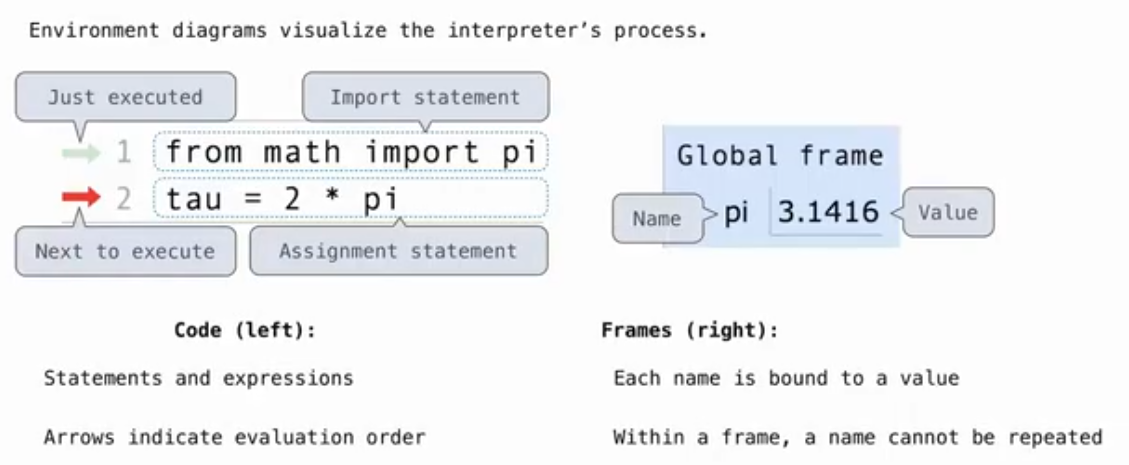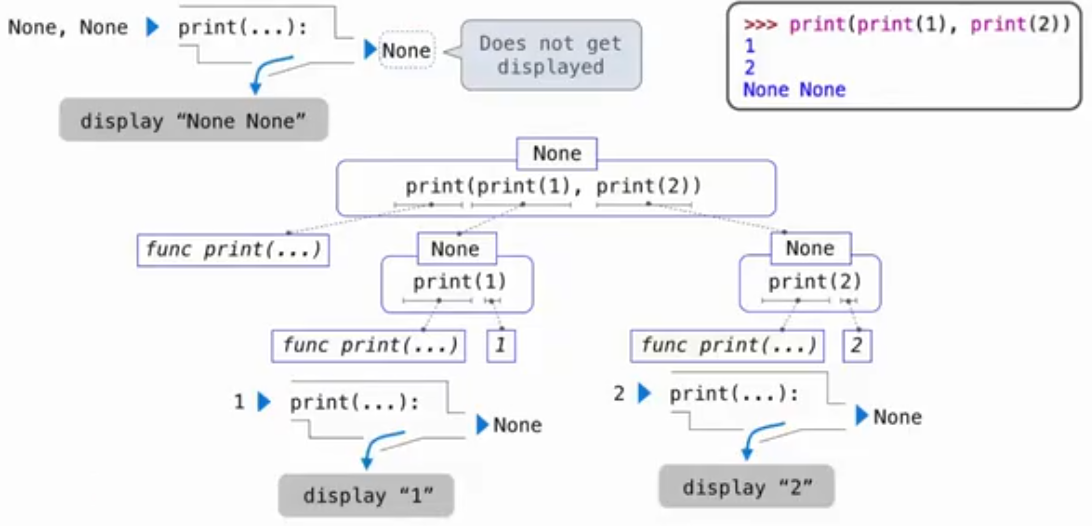CS61A
week1
Lecture
Welcome
The first lecture just a simple explaination of CS61A and explnation of the Expression Tree which is composed of a operator and several operands, so I just paste the picture of the Tree.
Easy but interesting.
If you learned data structure, you may think this isn-ary tree.
Functions
name
built-in
Like c/c++, python also has its own way to name or rename a parameter, a function or a variable and so on. The lecture will introduce it at beginning.
Ctrl + L is used to flash the terminal in python session.
>>> pi
Traceback (most recent call last):
File "<stdin>", line 1, in <module>
NameError: name 'pi' is not definedoops! No pi! This means the parameter is not a built-in parameter. We have to import it.
>>> from math import pi
>>> pi
3.141592653589793The same goes for imported functions.
>>> from math import sin
>>> sin(pi)
1.2246467991473532e-16
>>> sin(pi/2)
1.0You may find it not zero after sin(pi), because of the type of data storage in the computer or just a data cut. Not important.
name by ourselves
We can also name our own parameter:
>>> radius = 10
>>> radius
10Even multiple variables named simultaneously is also supported:
>>> area, circ = pi * radius *radius, 2 * pi * radius
>>> area
314.1592653589793
>>> circ
62.83185307179586The same goes for imported functions.
define
We can edit our functions by def:
>>> def square(x):
... return mul(x, x)
...
>>> square(11)
121If we change the value of parameter, the value of expression named by us will not change, but if define a functions will solve the issue:
>>> def area():
... return pi * radius * radius
...
>>> area()
314.1592653589793
>>> radius = 20
>>> area()
1256.6370614359173A function differs from a name in that its return expression here gets re-evaluated every time it's called.
defining functions
structure of defining:
>>> def <name>(<formal parameters>)
return <return expression>Fuctions will be evaluated when it is called.
The lecture also introduce the difference between local frames and global frames. I passed it for my c&c++ basics.
Environment Diagrams

Online Python Tutor:
https://pythontutor.com/visualize.html#
Print and None
Just talk about the difference of print and evaluate and Nonetype.
>>> None
>>> print(None)
None
Lab
Lab0:Getting Started
Download starter files from:
https://cs61a.org/lab/lab00/lab00.zip
Introduction
This lab explains how to setup your computer to complete assignments and introduces some of the basics of Python.
Components cheek passed, so skip them.
Setup
skip.
First Assignment
What Would Python Do?
Enter the following in your terminal to begin this section:
# we don't have edu email of berkeley, so we need to add --local
python ok -u --localEsay to pass:
=====================================================================
Assignment: Lab 0
OK, version v1.18.1
=====================================================================
~~~~~~~~~~~~~~~~~~~~~~~~~~~~~~~~~~~~~~~~~~~~~~~~~~~~~~~~~~~~~~~~~~~~~
Unlocking tests
At each "? ", type what you would expect the output to be.
Type exit() to quit
---------------------------------------------------------------------
Python Basics > Suite 1 > Case 1
(cases remaining: 1)
What would Python display? If you get stuck, try it out in the Python
interpreter!
>>> x = 20
>>> x + 2
? 22
-- OK! --
>>> x
? 20
-- OK! --
>>> y = 5
>>> y = y + 3
>>> y * 2
? 16
-- OK! --
>>> y + x
? 28
-- OK! --
---------------------------------------------------------------------Implementing Functions
lazy to think:
def twenty_twenty_four():
"""Come up with the most creative expression that evaluates to 2024
using only numbers and the +, *, and - operators.
>>> twenty_twenty_four()
2024
"""
return 2024 * 1 + 1 - 1Running Tests
use ok to check:
python ok --localcheck passed:
=====================================================================
Assignment: Lab 0
OK, version v1.18.1
=====================================================================
~~~~~~~~~~~~~~~~~~~~~~~~~~~~~~~~~~~~~~~~~~~~~~~~~~~~~~~~~~~~~~~~~~~~~
Running tests
---------------------------------------------------------------------
Test summary
2 test cases passed! No cases failed.Appendix: Useful Python Command Line Options
-i: opens an interactive session
python3 -i lab00.py
>>> 1
1-m doctest: run the examples in the docstrings of functions
# doctest
>>> twenty_twenty_four()
2024If all doctest passed, no outputs.
python3 -m doctest lab00.py